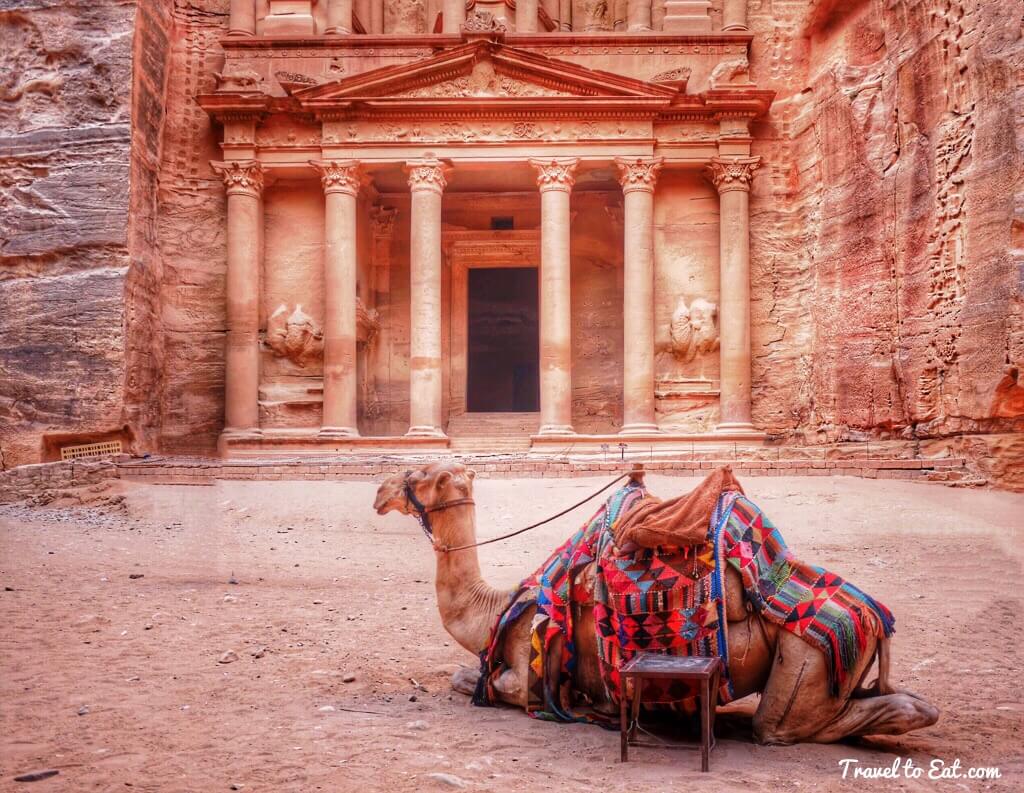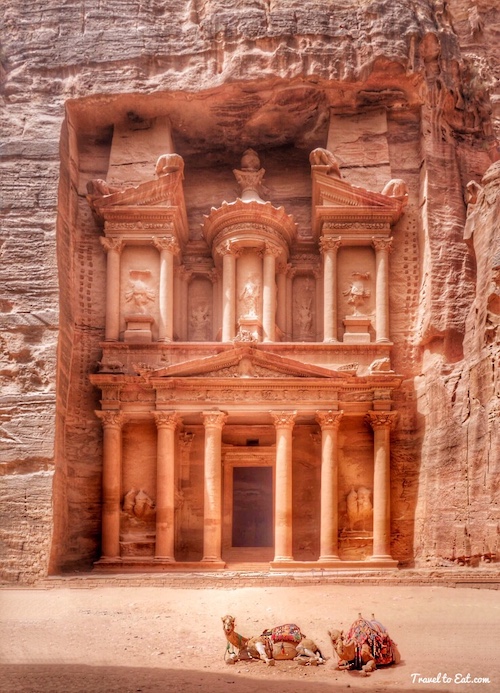
I have been traveling in the Middle East for some time now and because of poor internet connections, I have been posting mostly on social media. Now that I am in Jordan, the Internet is more reliable and I will be making short posts to which I will add future posts. Established possibly as early as 312 BC as the capital city of the Nabataeans, Petra is a symbol of Jordan, as well as Jordan's most-visited tourist attraction. It lies on the slope of Jebel al-Madhbah (identified by some as the biblical Mount Hor) in a basin among the mountains which form the eastern flank of Arabah (Wadi Araba), the large valley running from the Dead Sea to the Gulf of Aqaba. Perhaps the most famous image of Petra is seen above, Al Khazneh (“The Treasury” or in Arabic: الخزنة) which appears rather magically as you walk down the narrow canyon or wadi to the main part of Petra.

Al Khazneh was originally built as a mausoleum and crypt at the beginning of the 1st Century AD during the reign of Aretas IV Philopatris. Its Arabic name Treasury derives from one legend that bandits or pirates hid their loot in a stone urn high on the second level. Significant damage from bullets can be seen on the urn. Local lore attributes this to Bedouins, who are said to have shot at the urn in hopes of breaking it open and spilling out the “treasure” but the decorative urn is in fact solid sandstone. Another legend is that it functioned as a treasury of the Egyptian Pharaoh at the time of Moses (Khaznet Far'oun).
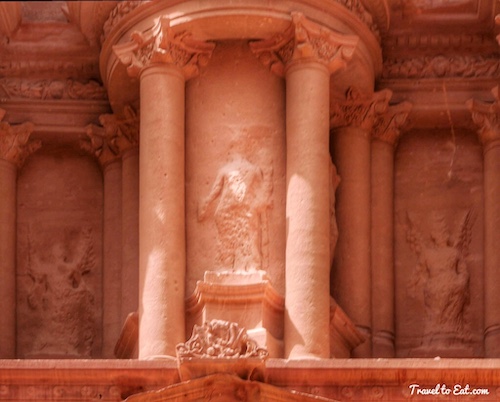


Many of the building's architectural details have eroded away during the two thousand years since it was carved and sculpted from the cliff. The sculptures are thought to be those of various mythological figures associated with the afterlife. On top are figures of four eagles that would carry away the souls. The figures on the upper level are dancing Amazons with double-axes. The entrance is flanked by statues of the twins Castor and Pollux who lived partly on Olympus and partly in the underworld.


Giving the Treasury a run for its money as the most impressive monument at Petra is the Monastery (a.k.a. al-Deir or ad-Dayr in Arabic), which is about an hour's climb north of Petra's city center. The Monastery is beautifully carved, though much less decorated than the Treasury, and so huge that even the doorway is several stories tall. Note the size of the tourist in relation to the massive facade, almost fifty metres square, carved from a Single chunk of the mountain. It is one of the largest monuments in Petra, measuring 47m wide by 48.3m high. It was built on the model of the Khazna but here the bas- reliefs are replaced by niches to house sculptures. A columned portico extends of the façade; the interior is occupied by two side benches and altar against the rear wall. It was used as a biclinium for the meetings of religious associations. It dates to the early 2nd century AD, during the reign of King Rabel II. In the hall was reused as a Christian chapel and crosses were carved in the rear wall thus the name “Monastery” (Dayr in Arabic).


While the ornamention of the “Monastary” is not as complex as the Treasury, it has withstood the ravages of time better, with little evidence of erosion or man made bulletin holes. During the winter solstice, the sun shines into the monastery at Petra in Jordan, illuminating the podium of a deity. As it does, the silhouette of the mountain opposite creates the image of a lion's head, a sacred animal in ancient Nabataean culture. Researchers believe this is one example of how ancient architects determined where and how to build religious centres using the motion of the sun in the skies of Petra.
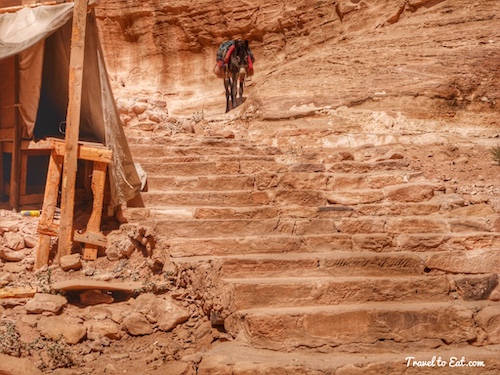

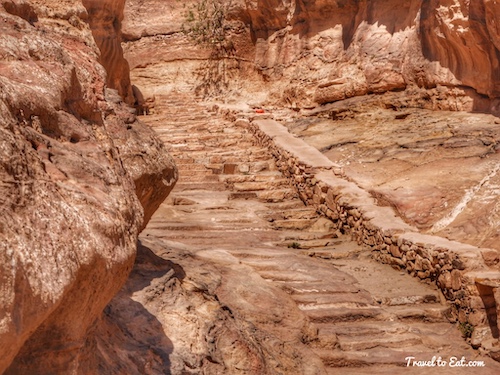

Do not underestimate the steepness of the climb or the number of steps to the Monastary. Nearly an hour’s climb northwest of the city centre, 220m above the elevation of the Qasr al-Bint the Monastary lies beyond the reach of all but the most determined travelers. Daunting though this sounds, there’s a well-trodden route the whole way – involving roughly eight hundred and fifty steps – as well as plenty of places to rest; a tranquil holy spring two-thirds of the way up is almost worth the climb by itself. Personally, I hired a guide and mule to take me up, a price well worth the cost. Beside the trail are plunging cliffs, hundreds of feet down and you must trust your mule to find the right path.



Some of the earliest recorded farmers settled in Beidha, a pre-pottery settlement just north of Petra, by 7000 BC. Petra is listed in Egyptian campaign accounts and the Amarna letters as Pel, Sela or Seir. Though the city was founded relatively late, a sanctuary has existed there since very ancient times. Stations 19 through 26 of the stations list of Exodus are places associated with Petra. Although Petra is usually identified with Sela, which means a rock, the Biblical references refer to it as “the cleft in the rock”, referring to its entrance. In the parallel passage, however, Sela is understood to mean simply “the rock”


Qasr Bint Farun (Palace of the Pharaoh’s Daughter) is Petra’s oldest and most venerable temple complex. Its name derived from a local legend that the same pharaoh who hid his treasure in the urn of the Treasury promised his daughter’s hand in marriage to the engineer who could develop a system to bring water to the palace. Several water channels have been found near it. The monument is almost square and is set on a podium. It was the main temple of Petra and it still stands to a height of 23 meters. Qasr al-Bint is a typical Hellenistic temple where only priests could enter inside and worshippers remained outside in the open temenos or holy area, where they may have olffered animal sacrifices. It is approached by a flight of 26 marble steps and four stucco-covered Corinthian columns between pilasters decorated the northern façade. Inside the temple, at the rear of the sanctuary, there are three compartments: the middle one protects an altar platform that housed images of the deity, and the two others were supplied with balcony terraces. It is believed that this temple was dedicated to Dushara, the main Nabatean god. The temple is dated to the first half of the 1st century AD and it is possible that it was a pilgrim destination.
For now I will stop here, as always I hope you enjoyed the photographs and the story.
References:
Petra: http://www.visitpetra.jo/Petra/AboutPetra.aspx#all
Petra Jordan: http://www.jordanembassy.org.au/petra
Treasury: http://www.sacred-destinations.com/jordan/petra-treasury
Monastary: http://www.sacred-destinations.com/jordan/petra-monastery
The Sun and Monastary: http://www.dailymail.co.uk/sciencetech/article-2595201/Petras-ancient-monastery-CALENDAR-Shadows-cast-carved-building-reveal-secrets-Jordans-lost-city.html

